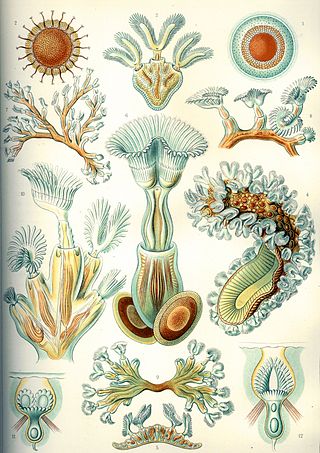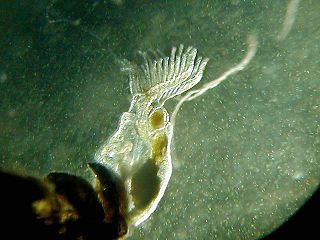
Bryozoa are a phylum of simple, aquatic invertebrate animals, nearly all living in sedentary colonies. Typically about 0.5 millimetres long, they have a special feeding structure called a lophophore, a "crown" of tentacles used for filter feeding. Most marine bryozoans live in tropical waters, but a few are found in oceanic trenches and polar waters. The bryozoans are classified as the marine bryozoans (Stenolaemata), freshwater bryozoans (Phylactolaemata), and mostly-marine bryozoans (Gymnolaemata), a few members of which prefer brackish water. 5,869 living species are known. At least two genera are solitary ; the rest are colonial.
Stenolaemata are a class of exclusively marine bryozoans. Stenolaemates originated and diversified in the Ordovician, and more than 600 species are still alive today. All extant (living) species are in the order Cyclostomatida, the third-largest order of living bryozoans.

Phylactolaemata is a class of the phylum Bryozoa whose members live only in freshwater environments. Like all bryozoans, they filter feed by means of an extensible "crown" of ciliated tentacles called a lophophore, and like nearly all bryozoans, they live in colonies, each of which consists of clones of the founding member. Unlike those of some marine bryozoans, phylactolaemate colonies consist of only one type of zooid, the feeding forms known as autozooids. These are supported by an unmineralized "exoskeleton" made of gelatinous material or protein, secreted by the zooids. The class contains only one extant order, Plumatellida.

Trepostomatida is an extinct order of bryozoans in the class Stenolaemata. Trepostome bryozoans possessed mineralized calcitic skeletons and are frequently fossilized; some of the largest known fossilized bryozoan colonies are branching trepostomes and massive dome-shaped trepostomes. Trepostomes did not have many specialized zooecia beyond ordinary feeding autozooecia. The two main known heteromorphs are exilazooecia and mesozooecia, which had the purpose of maintaining regular spacing between autozooecia.
Lunostoma is an extinct genus of bryozoans which existed during the middle Devonian of what is now Germany, precisely from the Gerolstein syncline. It was described by Andrej Ernst, Paul D. Taylor, Jan Bohatý and Patrick N. Wyse Jackson in 2012, and the type species is L. pulchra.
Chasmatopora is an extinct genus of bryozoans which existed in what is now Mongolia, China, Estonia, Russia, Poland, Argentina, the United States and Canada. It was described by Alcide d'Orbigny in 1849, and the type species is Chasmatopora tenella, which was originally described as a species of Retepora by Eichwald in 1842.
Fenestrata is an extinct order of bryozoan, dating from the Upper Arenig. Most fenestrate bryozoans formed net-like colonies, often in funnel- or fan-shaped forms, with a single layer of zooids facing one direction. The colony shape served as a filter-feeding apparatus that water currents flowed through, with autozooecial apertures only on the side of the colony facing into the current. This colony structure was vulnerable to predators, so some fenestrate bryozoans produced skeletal superstructures, likely to strengthen or protect the colony, and others had protective spines surrounding their autozooecial apertures.
Ceramopora is an extinct genus of bryozoan of the family Ceramoporidae. It is one of the earliest genera of bryozoans. Its colonies were thin and discoid, with large autozooecia, abundant communication pores, lunaria, and monticules with depressions in their centers. It had no acanthostyles or diaphragms, distinguishing it from Acanthoceramoporella.
Paleontology or palaeontology is the study of prehistoric life forms on Earth through the examination of plant and animal fossils. This includes the study of body fossils, tracks (ichnites), burrows, cast-off parts, fossilised feces (coprolites), palynomorphs and chemical residues. Because humans have encountered fossils for millennia, paleontology has a long history both before and after becoming formalized as a science. This article records significant discoveries and events related to paleontology that occurred or were published in the year 2015.
Septopora is an extinct genus of bryozoan belonging to the order Fenestrida. It has been found in Pennsylvanian to Permian beds in North America, South America, Australia, and southwest and east Asia.
Homotrypa is an extinct genus of bryozoans from the Ordovician and Silurian periods, known from fossils found in the United States. Its colonies are branch-like and have small monticules made of groups of three or four larger zooecia slightly protruding out from the main surface of the colony. In cross section, the zooecia are erect in axis and gently curve toward the surface of the colony.
Eridotrypa is an extinct genus of bryozoans of the family Aisenvergiidae, consistently forming colonies made of thin branches. Diaphragms are very common in colonies. Distinctively, in the exozone there are serrated dark borders separating the autozooecia.
Laxifenestella is an extinct genus of bryozoans of the family Fenestellidae, found from the Devonian period to the Permian 412.3 to 254.0 million years ago. The genus colonies consist of a mesh of mostly straight branches in a fan-like or funnel-like shape. There are several species belonging to the Laxifenestella genus being L. borealis, L. texana, L. contracta, L. exserta, L. firma, L. morozova, L. lahuseni, L. oviferorsa, L. sarytshevae, L. stuchugorensis and L. stuckenbergi. Parent taxon of this genus is Fenestellidae with siste taxons being Alternifenestella, Minilya, Spinofenestella. Fossils of the laxifenestella genus in the permian period are found in Australia, Canada, Iran, Omen, Pakistan, and Russia. Fossils from the Carboniferous period are found in spain with Devonian period fossils being found in the Czech Republic. In total there are 22 fossils belonging to the Laxifenestella genus.
Mirifenestella is an extinct genus of bryozoans from the Devonian period, belonging to the order Fenestrata. Like some other fenestrate bryozoans, it produced a skeletal superstructure that protected the colony. It also developed specialized zooids known as "aviculomorphs" which occurred in pairs and may have been either for cleaning or defense purposes.
Fenestrapora is an extinct genus of bryozoans of the family Semicosciniidae that lived during the Devonian period. Its colonies have a net-like structure, shaped into a flaring funnel. It is distinct from most other fenestrate bryozoans due to its aviculomorphs, structures that are thought to have had the function of cleaning or defense.
Quadrisemicoscinium is an extinct genus of fenestrate bryozoan, known from the Early Devonian period, of the family Semicosciniidae. It formed net-like colonies of relatively thick branches with two rows of autozooids per branch, supported by a vesicular skeleton.
Pharopora is an extinct genus of bryozoan of the family Rhabdomesidae that lived in the Mississippian period. It is characterized by colonies with branches possessing regular internodes and articulating cone-shaped terminations. It is the first genus of bryozoan in the family Rhabdomesidae with articulated (jointed) parts in its colonies.
Arthrostyloecia is an extinct genus of bryozoan of the family Arthrostylidae, that lived in the Ordovician period. Its colonies are articulated, distinctively containing ball and socket joints. It contains a single species, Arthrostyloecia nitida.
Fistuliphragma is an extinct genus of cystoporate bryozoan of the family Fistuliporidae that lived in the Devonian period. Its colonies could have branched or encrusting forms, with hollow tubular branches in the case of the branched form, and possessed a well-developed vesicular skeleton. Its autozooecia possessed prominent lunaria and hemiphragms. The genus is distinct from Cliotrypa and Strotopora because of the absence of gonozooecia.
Palaeostomata is a superorder of extinct stenolaemate bryozoans, including all extinct orders within Stenolaemata and excluding the order Cyclostomata, which is the only extant stenolaemate order. Palaeostomates are sometimes called "stony bryozoans" because they are heavily calcified, making them ideal candidates for fossilization. They are distinct from cyclostomes because they lack calcified exterior walls above the basal lamina and because their zooecial tubes are transected by calcitic partitions, such as diaphragms.


